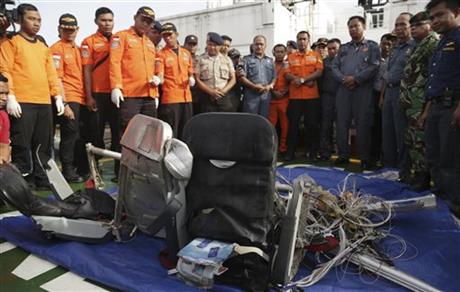
By ACHMAD IBRAHIM
A day after the tail of the crashed AirAsia plane was fished out of the Java Sea, the search for the missing black boxes intensified Sunday, with more pings heard in two different locations.
Three Indonesian ships detected the signals, said Indroyono Soesilo, coordinating minister for Maritime Affairs. They were located up to 4 kilometers (2.5 miles) from where the aircraft’s rear was discovered.
“The two are close to each other, just about 20 meters (yards),” Soesilo told reporters. “Hopefully, they are the cockpit voice recorder and flight data recorder.”
Other officials cautioned it was too soon to know whether the sounds were coming from the black boxes, which detached from the tail when the plane plummeted into the sea Dec. 28, killing all 162 people on board.
The Commission for Transportation Safety stopped a remote-operated vehicle from being deployed to probe the area where the pings were heard, fearing it could potentially cause damage to the boxes, said Muhammad Ilyas, head of oceanic surveys at Indonesia’s technology agency. Instead, the sites will be examined by divers.
In addition, sonar on Sunday detected a large object in the same vicinity as the pings. Suryadi Bambang Supriyadi, operation director of the country’s national search and rescue agency, said he’s hopeful it’s the main section of the Airbus A320’s cabin.
“If that is true, then maybe many bodies are still there,” he said, adding that divers would be sent in to look.
So far, only 48 corpses have been recovered. Search efforts have been consistently hampered by big waves and powerful currents created by the region’s rainy season. Silt and sand, along with murky river runoff, have created blinding conditions for divers.
The tail’s excavation was a major success in the slow-moving hunt for victims and wreckage from Flight 8501. The red metal chunk from the tail, with the words “AirAsia” clearly visible across it, was brought to the surface on Saturday using inflatable balloons.
But the find was tinged with disappointment when the black boxes were not found still attached. Their beacons emit signals for about 30 days until the batteries die, meaning divers have about two weeks left before they go silent.
The debris from the tail was brought up from a depth of about 30 meters (100 feet) and towed to a ship, where it was hoisted onto the deck. The vertical stabilizer was still largely intact, but the attached jagged fuselage was ripped open and tangled by a mess of wires.
AirAsia CEO Tony Fernandes expressed optimism earlier Sunday that the effort was gaining momentum.
“Let’s hope today is a major breakthrough day and we can find (the) main fuselage,” he wrote in a Twitter post. Many believe most of the bodies are likely entombed inside the aircraft on the seabed.
Several other large objects have been spotted in the search area by sonar, but they have not yet been explored underwater.
Three more bodies were identified Sunday, including Park Seongbeom, 37, and his wife, Lee Kyung Hwa, 34, from South Korea, said Budiyono, who heads East Java’s Disaster Victim Identification unit and, like many Indonesians, uses only one name.
He said they were discovered Friday on the seabed, still strapped to their seats. Their baby has not yet been found, but the infant’s carrier was still attached to the man.
Sixteen recovered corpses remain unidentified, partially due to decomposition, Budiyono said. Nearly all of the passengers were Indonesian.
The last contact the pilots had with air traffic control, about halfway into their two-hour journey from Indonesia’s second-largest city, Surabaya, to Singapore, indicated they were entering stormy weather. They asked to climb from 32,000 feet (9,753 meters) to 38,000 feet (11,582 meters) to avoid threatening clouds, but were denied permission because of heavy air traffic. Four minutes later, the plane dropped off the radar. No distress signal was issued.
___
Associated Press writer Ali Kotarumalos in Jakarta, Indonesia, contributed to this report.



